Fire Risk of Polyethylene (PE)-Based Foam Blocks Used as Interior Building Materials and Fire Suppression through a Simple Surface Coating: Analysis of Vulnerability, Propagation, and Flame Retardancy
Abstract
:1. Introduction
2. Materials and Methods
2.1. Flame Retardancy
2.2. Heat Release Rate
2.3. Spread of Flame Test
2.4. Flame-Retardant Surface Coating
3. Results and Discussion
3.1. Flame-Retardant Properties
3.2. Comparison of Heat Release Rate
3.3. Spread of Flame Test
3.4. Flame-Retardant Performance of MMT
4. Conclusions
Supplementary Materials
Author Contributions
Funding
Informed Consent Statement
Data Availability Statement
Conflicts of Interest
References
- Pile, J. Interior Design, 4th ed.; Prentice Hall: Hoboken, NJ, USA, 2007; pp. 11–56. [Google Scholar]
- Liu, C.; Deng, T.; Zhou, S.; Yan, R.; Huang, L. Experimental investigation on fire assessment for typical interior wallpapers. Fire Technol. 2022, 58, 991–1009. [Google Scholar] [CrossRef]
- Yang, H.; Kim, D.; Kim, H. Combustion and mechanical properties of fire retardant treated waste paper board for interior finishing material. J. Fire Sci. 2002, 20, 505–517. [Google Scholar] [CrossRef]
- Konecki, M.; Galaj, J. Flame transfer through the external walls insulation of the building during a fire. Procedia Eng. 2017, 172, 529–535. [Google Scholar] [CrossRef]
- Efe, R.; Matchavariani, L.; Yaldir, A.; Levai, L. Developments in Science and Engineering. In Interior Finishing Materials, 1st ed.; Koca, G., Ed.; St. Kliment Ohridski University Press: Sofia, Bulgaria, 2016; pp. 606–618. [Google Scholar]
- Taylor, C. The Design, Production and Reception of Eighteenth-Century Wallpaper in Britain, 1st ed.; Routledge: London, UK, 2018; pp. 45–100. [Google Scholar]
- Choi, Y.; Joe, I.; Lee, S.; Oh, K. An experimental study on the ignition and emissions characteristics of wallpapers. J. Mech. Sci. Technol. 2009, 23, 2839–2847. [Google Scholar] [CrossRef]
- Al-Baldawi, M.T. Application of smart materials in the interior design of smart houses. Civ. Environ. Res. 2015, 7, 1–15. [Google Scholar]
- Li, W.; Zhao, L.; Zhang, Q.; Zhao, G. Flame retardance and antibacterial performance of wooden wallpaper treated with composite modified agent. Wood Res. 2016, 61, 423–432. [Google Scholar]
- Tian, N.; Delichatsios, M.A.; Zhang, J.; Fateh, T. A methodology and a simple engineering fire performance model for intumescent fire retardant coatings. Fire Saf. J. 2018, 98, 120–129. [Google Scholar] [CrossRef]
- Popescu, C.; Pfriem, A. Treatment and modification to improve the reaction to fire of wood and wood based products—An overview. Fire Mater. 2020, 44, 100–111. [Google Scholar] [CrossRef]
- Chen, F.; Zhu, Y.; Chen, F.; Dong, L.; Yang, R.; Xiong, Z. Fire alarm wallpaper based on fire-resistant hydroxyapatite nanowire inorganic paper and graphene oxide thermosensitive sensor. ACS Nano 2018, 12, 3159–3171. [Google Scholar] [CrossRef]
- Weil, E.D. Fire-protective and flame-retardant coatings- A state of the art review. J. Fire Sci. 2011, 29, 259–296. [Google Scholar] [CrossRef]
- Salasinska, K.; Mizera, K.; Celiński, M.; Kozikowski, P.; Borucka, M.; Gajek, A. Thermal properties and fire behavior of polyethylene with a mixture of copper phosphate and melamine phosphate as a novel flame retardant. Fire Saf. J. 2020, 115, 103137. [Google Scholar] [CrossRef]
- Cho, S.O.; Kim, Y.S. A study on data research for fire regulations and fire retardant in interior architecture. Korean Inst. Inter. Des. J. 2010, 19, 95–102. [Google Scholar]
- Law Viewer, Firefighting System Installation Business Act. Available online: https://elaw.klri.re.kr/eng_mobile/viewer.do?hseq=54812&type=part&key=12 (accessed on 3 May 2023).
- Sabee, M.M.S.M.; Itam, Z.; Beddu, S.; Zahari, N.M.; Kamal, N.L.M.; Mohamad, D.; Zulkepli, N.A.; Shafiq, M.D.; Hamid, Z.A.A. Flame retardant coatings: Additives, binders, and fillers. Polymers 2022, 14, 2911. [Google Scholar] [CrossRef] [PubMed]
- Boonmee, N.; Quintiere, J.G. Glowing ignition of wood: The onset of surface combustion. Proc. Combust. Inst. 2005, 30, 2303–2310. [Google Scholar] [CrossRef]
- Wang, S.; Wang, X.; Wang, X.; Li, H.; Sun, J.; Sun, W.; Yao, Y.; Gu, X.; Zhang, S. Surface coated rigid polyurethane foam with durable flame retardancy and improved mechanical property. J. Chem. Eng. 2020, 385, 123755. [Google Scholar] [CrossRef]
- Huang, Y.; Jiang, S.; Liang, R.; Liao, Z.; You, G. A green highly-effective surface flame-retardant strategy for rigid polyurethane foam: Transforming UV-Cured coating into intumescent self-extinguishing layer. Compos. Part A Appl. Sci. Manuf. 2019, 125, 105534. [Google Scholar] [CrossRef]
- Droździel-Jurkiewicz, M.; Bieniaś, J. Evaluation of surface treatment for enhancing adhesion at the metal-composite interface in fibre metal-laminates. Materials 2022, 15, 6118. [Google Scholar] [CrossRef]
- Yang, H.; Yu, B.; Song, P.; Maluk, C.; Wang, H. Surface-coating engineering for flame retardant flexible polyurethane foams: A critical review. Compos. Part B Eng. 2019, 176, 107185. [Google Scholar] [CrossRef]
- Hasnain, M.; Nayak, A.K. Alginate-Inorganic Composite Particles as Sustained Drug Delivery Matrics. In Applications of Nanocomposite Materials in Drug Delivery, 1st ed.; Inamuddin, A.M.S., Mohammad, A., Eds.; Woodhead Publishing: New York, NY, USA, 2018; pp. 39–74. [Google Scholar]
- Pavlidou, S.; Papaspyrides, C.D. A review on polymer-layered silicate nanocomposites. Prog. Polym. Sci. 2018, 33, 1119–1198. [Google Scholar] [CrossRef]
- Shared Growth in the Wallpaper, Paint, and Tile Self-Interior Market. Available online: https://m.dnews.co.kr/m_home/view.jsp?idxno=201607041448392460058 (accessed on 9 July 2023).
- Popularity of Simple Heating Products in ‘Sparkling Cold’. Available online: https://www.yna.co.kr/view/AKR20161102180100030 (accessed on 9 July 2023).
- Yavari, S.A.; Croes, M.; Akhavan, B.; Jahanmard, F.; Eigenhuis, C.C.; Dadbakhsh, S.; Vogely, H.C.; Bilek, M.M.; Fluit, A.C.; Boel, C.H.E.; et al. Layer by layer coating for bio-functionalization of additively manufactured meta-biomaterials. Addit. Manuf. 2020, 32, 100991. [Google Scholar]
- Chen, Y.; Feng, Q.; Nie, Y.; Zhang, J.; Yang, L. A review of combustion and flame spread over thermoplastic materials: Research advances and prospects. Fire 2023, 6, 125. [Google Scholar] [CrossRef]
- ISO 5660-1:2015; Reaction to Fire Test—Heat Release, Smoke Production and Mass Loss Rate—Part 1: Heat Release Rate (Cone Calorimeter Method) and Smoke Production Rate (Dynamic Measurement). International Organization for Standardization: Geneva, Switzerland, 2015. Available online: https://www.iso.org/standard/57957.html (accessed on 9 July 2023).
- Yang, X.; Zhang, W. Flame Retardancy of Wood-Polymeric Composites. In Polymer-Based Multifunctional Nanocomposites and Their Applications, 1st ed.; Song, K., Liu, S., Guo, J.Z., Eds.; Elsevier Inc.: New York, NY, USA, 2019; pp. 285–317. [Google Scholar]
- Östman, B. Acceptance criteria for products according to the cone calorimeter. Fire Mater. 2023, 47, 848–850. [Google Scholar] [CrossRef]
- Fina, A.; Gamino, G.; Bocchini, S. Comprehensive Approach to Flame-Retardancy Evaluation of Layered Silicate Nanocomposites. In Polymer Green Flame Retardants, 1st ed.; Papaspyrides, C.D., Kiliaris, P., Eds.; Elsevier Inc.: New York, NY, USA, 2014; pp. 441–459. [Google Scholar]
- ISO 5658-2:2006; Reaction to Fire Tests—Spread of Flame—Part 2: Lateral Spread on Building and Transport Products in Vertical Configuration. International Organization for Standardization: Geneva, Switzerland, 2006. Available online: https://www.iso.org/standard/36963.html (accessed on 19 July 2023).
- Radziszewska-Wolińska, J.M.; Milczarek, D. Fire tests of non-metallic materials for walls and ceiling in rolling stock. Mater. Res. Proc. 2018, 5, 90–95. [Google Scholar]
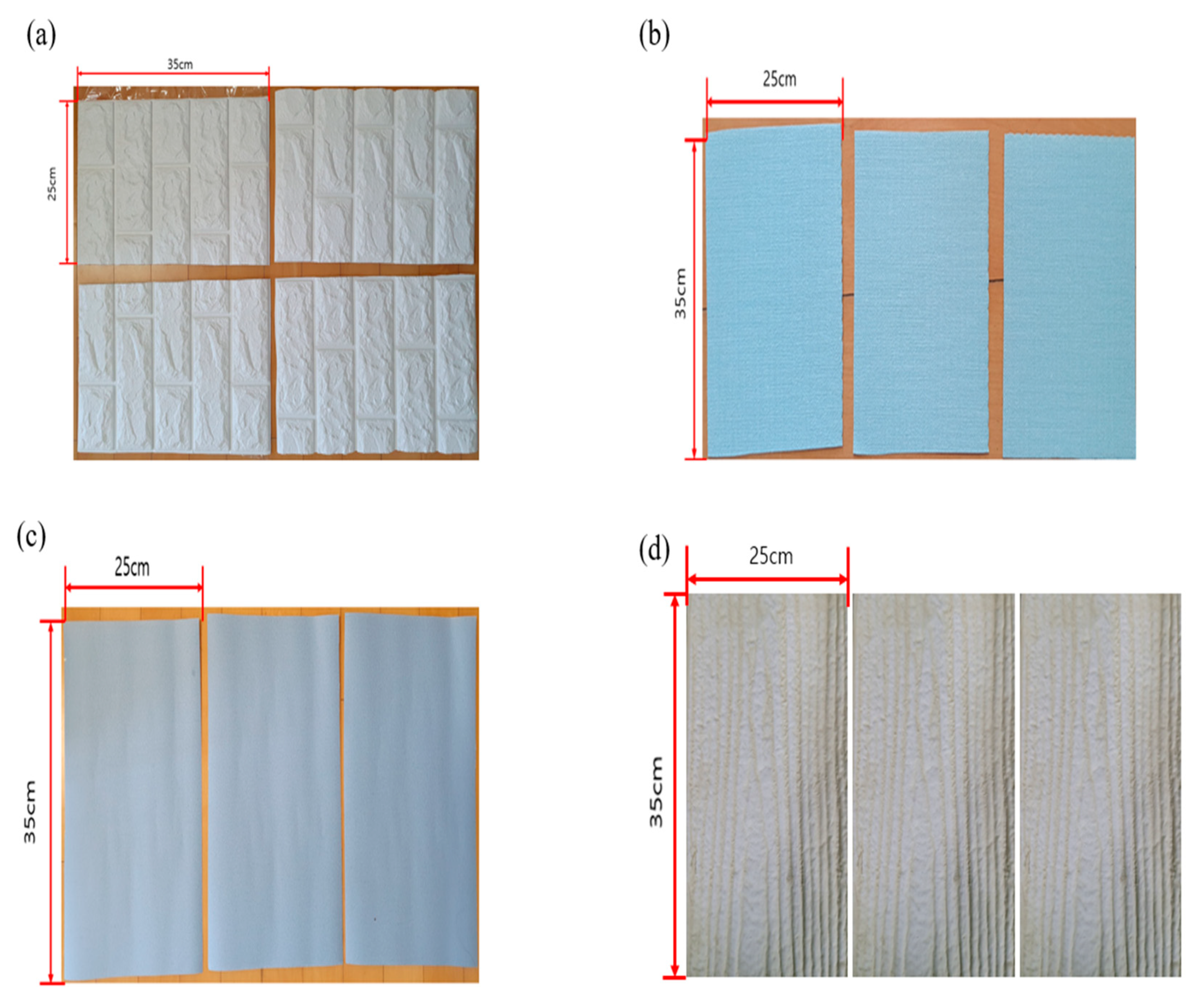
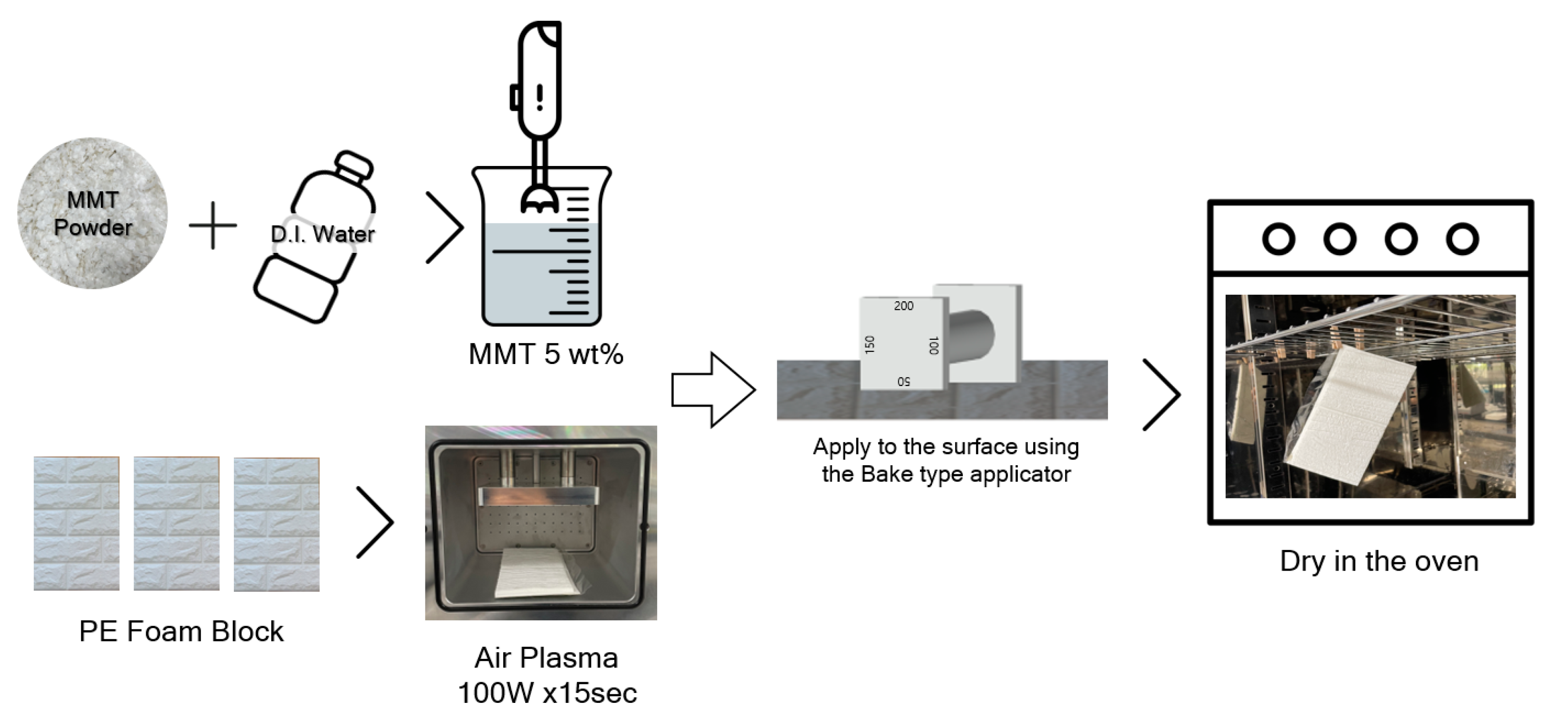
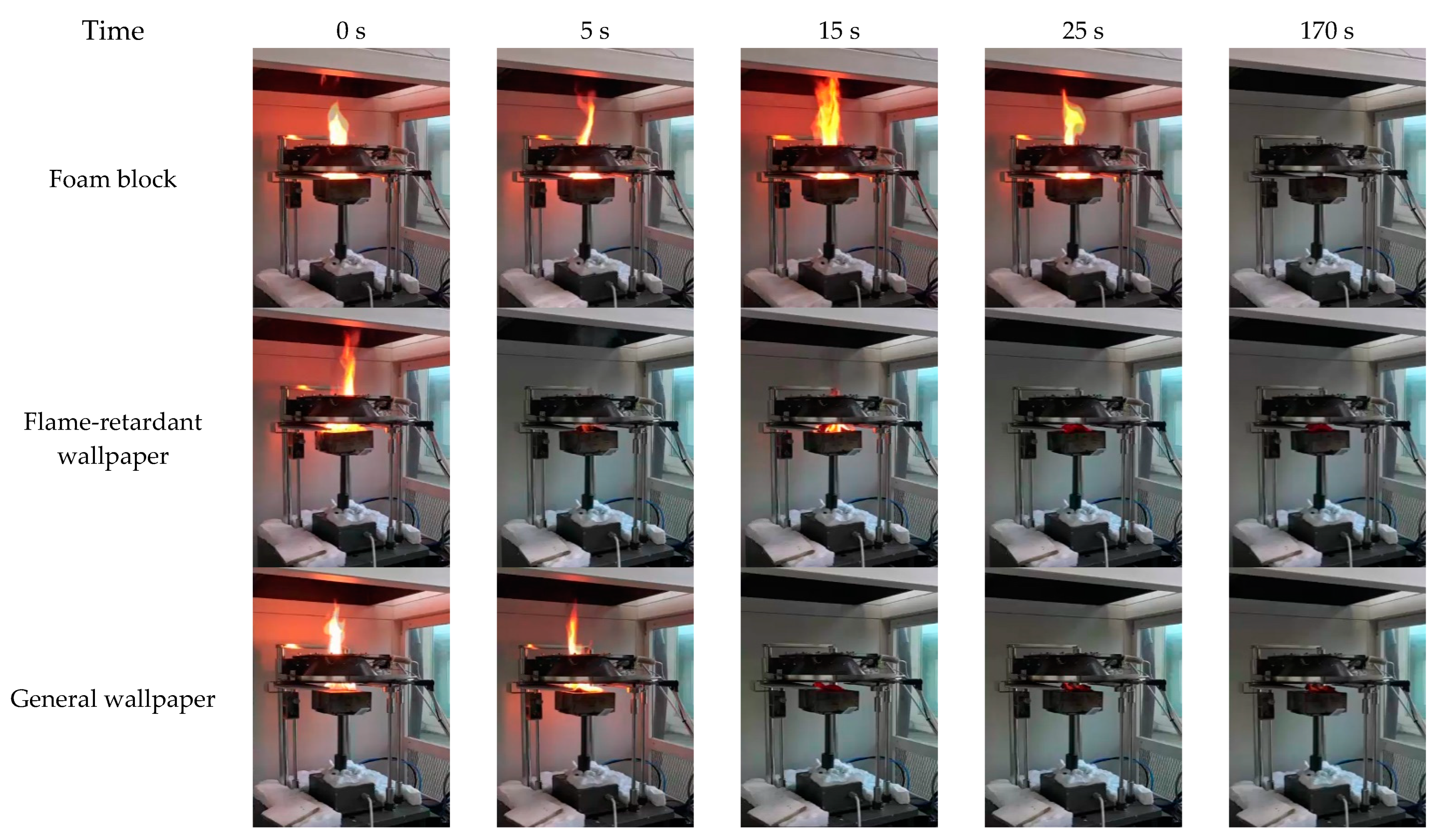
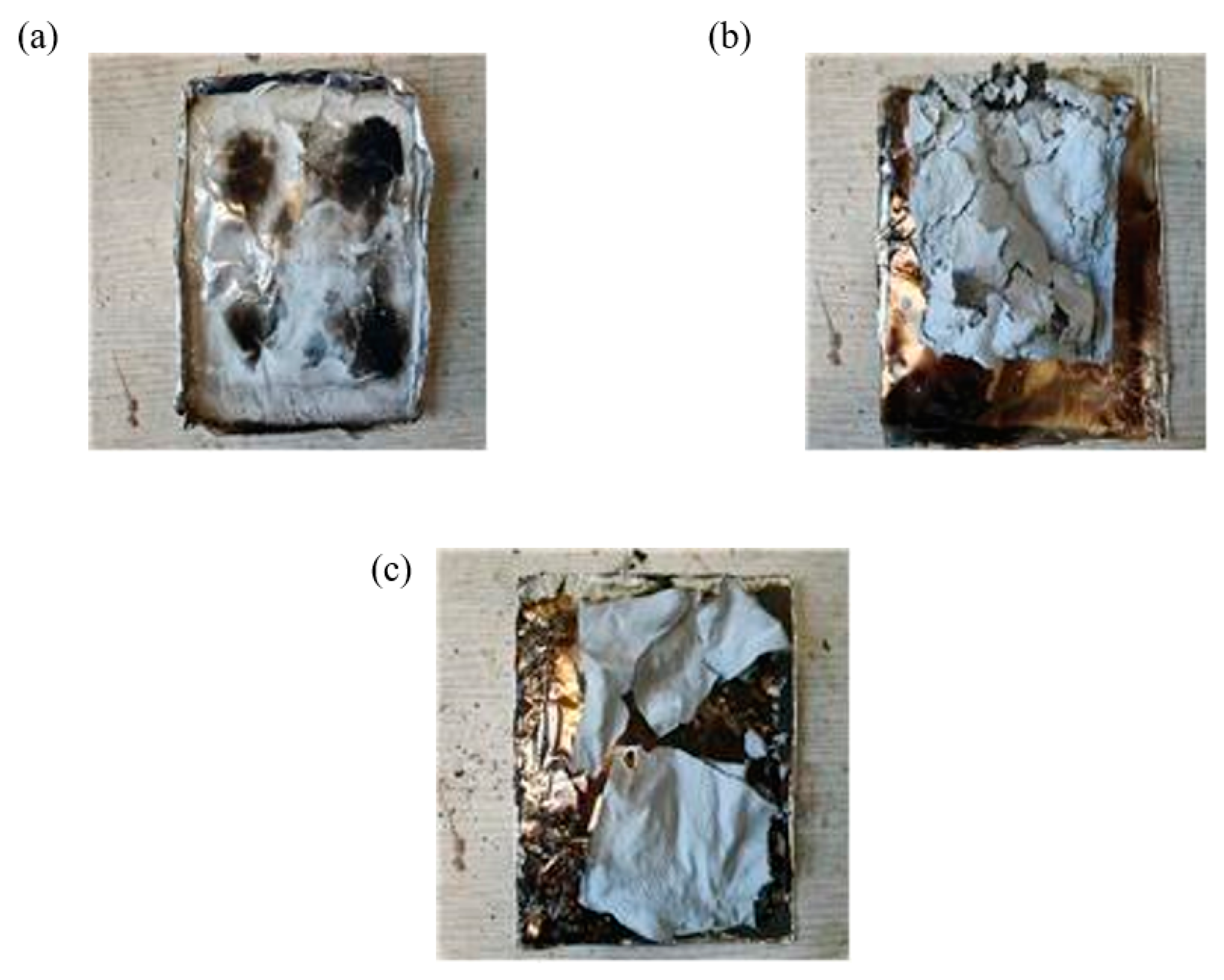
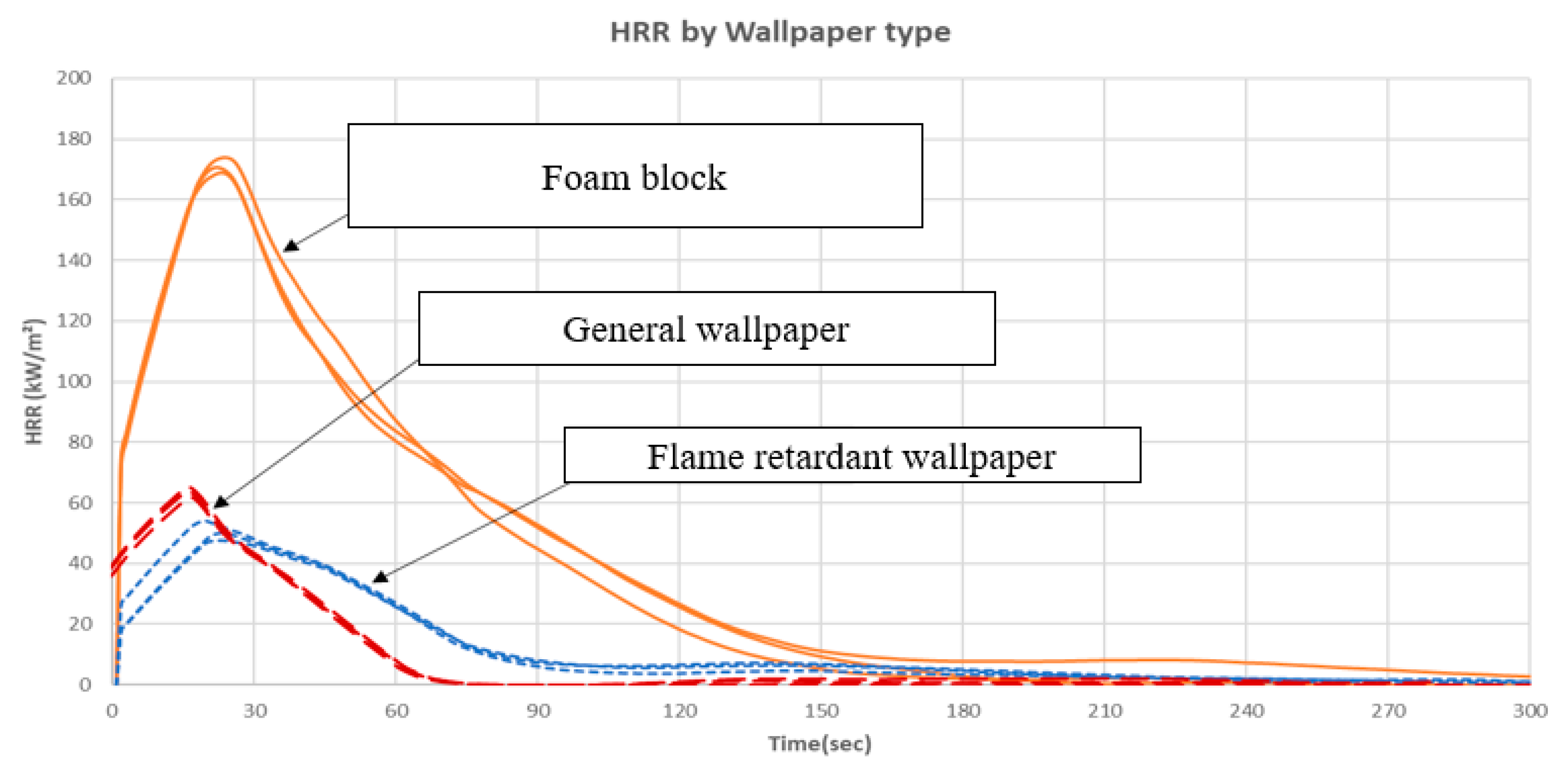
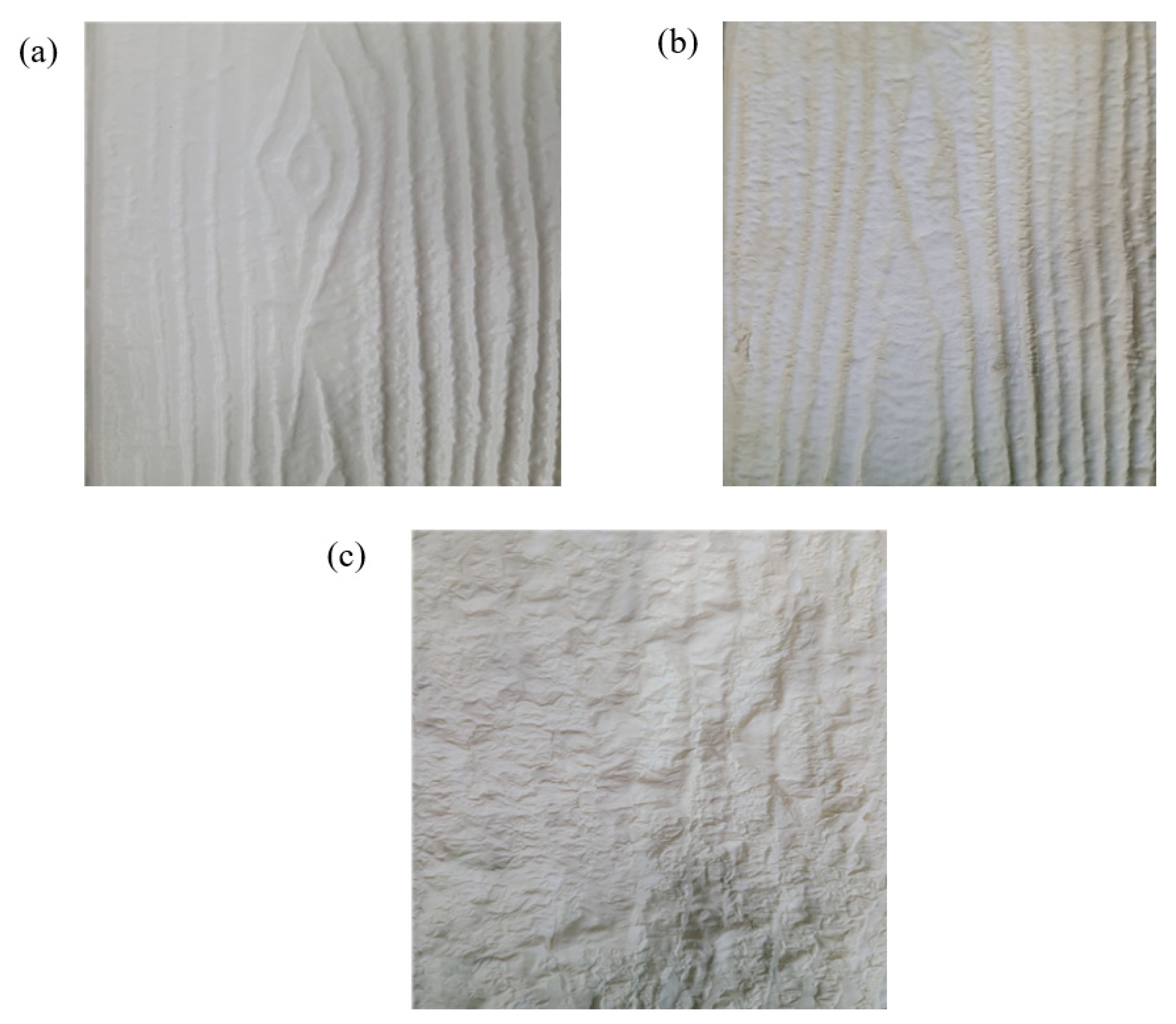
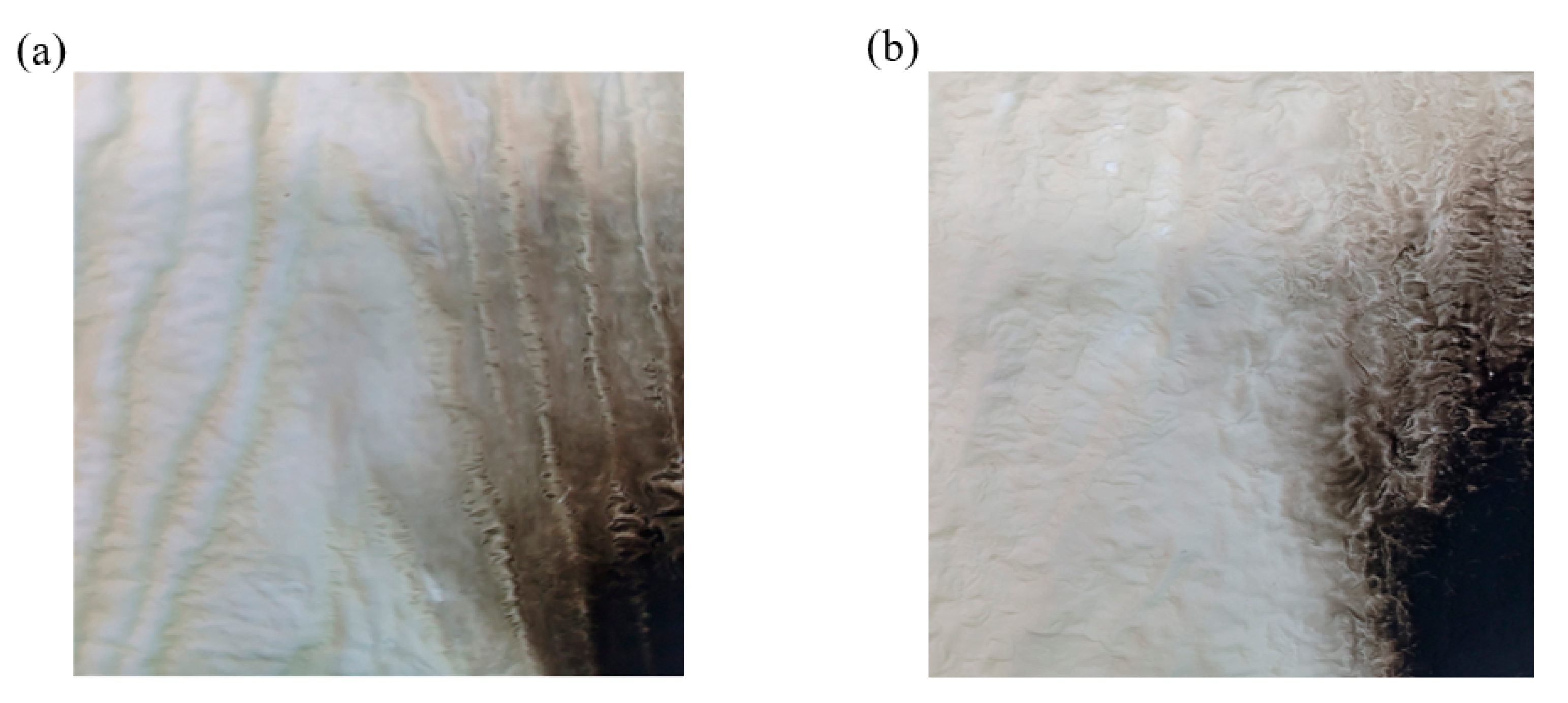
| Types of Materials | After-Flame Time | After-Glow Time | Standards Carbonization Areas | Carbonization Length | Flame Contact Time |
|---|---|---|---|---|---|
| Carpet | Within 20 s | - | - | 10 cm | - |
| Thin fabric | Within 3 s | Within 5 s | Within 30 cm | Within 20 cm | >3 s |
| Thick fabric | 5 s | 20 s | 40 cm | 20 cm | 3 s |
| Synthetic resin plate | 5 s | 20 s | 40 cm | 20 cm | - |
| Plywood, fiberboard, wood, etc. | 10 s | 30 s | 50 cm | 20 cm | - |
| Test Sample (No) | After-Flame Time | Afterglow Time | Carbonization Area (cm2) | Carbonization Length (cm) | Flame Contact Time | Flame Retardancy | |
|---|---|---|---|---|---|---|---|
| Insulated wallpaper (foam block) | 1 | Burned down | Burned down | Burned down | Burned down | Burned down | Ordinary (combustibles) |
| 2 | |||||||
| 3 | |||||||
| Flame-retardant wallpaper | 1 | 0.0 | 0.0 | 27.8 | 6.9 | Not applicable | Flame-retardant material |
| 2 | 0.0 | 0.0 | 28.5 | 7.2 | |||
| 3 | 0.0 | 0.0 | 28.1 | 7.0 | |||
| General wallpaper | 1 | Burned down | Burned down | Burned down | Burned down | Burned down | Ordinary (combustibles) |
| 2 | |||||||
| 3 | |||||||
| Test Sample (No) | Ignition (s) | Flame Extinction Time (s) | THR (MJ/m2) | Mass Loss Rate (%) | Fire Class | |
|---|---|---|---|---|---|---|
| in 5 min | ||||||
| Insulated wallpaper (foam block) | 1 | Immediately | 165 | 11.9 | ≥95 | Ordinary (combustibles) |
| 2 | Immediately | 165 | 10.4 | |||
| 3 | Immediately | 180 | 11.3 | |||
| Flame-retardant wallpaper | 1 | Immediately | 20 | 3.2. | ≥95 | Flame-retardant material |
| 2 | Immediately | 24 | 3.4 | |||
| 3 | Immediately | 23 | 3.3 | |||
| General wallpaper | 1 | Immediately | 16 | 5.0 | ≥95 | Ordinary (combustibles) |
| 2 | Immediately | 16 | 4.9 | |||
| 3 | Immediately | 16 | 5.2 | |||
| Test Sample (No) | Carbonization Length (mm) | Critical Flux at Extinguishment (CFE) (kW/m2) | Heat for Sustained Burning (Qsb) (MJ/m2) | Test Time (s) | |
|---|---|---|---|---|---|
| Insulated wallpaper (foam block) | 1 | 4 | 800 | 0.8 | 0.28 |
| 2 | 4 | 800 | 0.8 | 0.29 | |
| 3 | 4 | 800 | 0.8 | 0.35 | |
| Average | 4 | 800 | 0.8 | 0.3 | |
| Flame-retardant wallpaper | 1 | 69 | 200 | 42.81 | - |
| 2 | 72 | 150 | 47.47 | - | |
| 3 | 6 | 100 | 49.59 | - | |
| Average | 49 | 150 | 47 | - | |
| General wallpaper | 1 | 53 | 400 | 18.3 | 2.55 |
| 2 | 51 | 350 | 23.7 | 2.58 | |
| 3 | 48 | 350 | 23.7 | 2.46 | |
| Average | 51 | 367 | 22 | 2.5 | |
Disclaimer/Publisher’s Note: The statements, opinions and data contained in all publications are solely those of the individual author(s) and contributor(s) and not of MDPI and/or the editor(s). MDPI and/or the editor(s) disclaim responsibility for any injury to people or property resulting from any ideas, methods, instructions or products referred to in the content. |
© 2023 by the authors. Licensee MDPI, Basel, Switzerland. This article is an open access article distributed under the terms and conditions of the Creative Commons Attribution (CC BY) license (https://creativecommons.org/licenses/by/4.0/).
Share and Cite
Jeon, Y.; Park, J.; Park, J.; Kang, C. Fire Risk of Polyethylene (PE)-Based Foam Blocks Used as Interior Building Materials and Fire Suppression through a Simple Surface Coating: Analysis of Vulnerability, Propagation, and Flame Retardancy. Fire 2023, 6, 350. https://doi.org/10.3390/fire6090350
Jeon Y, Park J, Park J, Kang C. Fire Risk of Polyethylene (PE)-Based Foam Blocks Used as Interior Building Materials and Fire Suppression through a Simple Surface Coating: Analysis of Vulnerability, Propagation, and Flame Retardancy. Fire. 2023; 6(9):350. https://doi.org/10.3390/fire6090350
Chicago/Turabian StyleJeon, Yongtae, Jungwoo Park, Jongyoung Park, and Chankyu Kang. 2023. "Fire Risk of Polyethylene (PE)-Based Foam Blocks Used as Interior Building Materials and Fire Suppression through a Simple Surface Coating: Analysis of Vulnerability, Propagation, and Flame Retardancy" Fire 6, no. 9: 350. https://doi.org/10.3390/fire6090350
APA StyleJeon, Y., Park, J., Park, J., & Kang, C. (2023). Fire Risk of Polyethylene (PE)-Based Foam Blocks Used as Interior Building Materials and Fire Suppression through a Simple Surface Coating: Analysis of Vulnerability, Propagation, and Flame Retardancy. Fire, 6(9), 350. https://doi.org/10.3390/fire6090350








